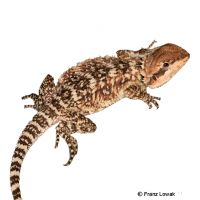Kimberley Bearded Dragon (Pogona microlepidota)
| Kimberley Bearded Dragon Pogona microlepidota | |
|---|---|
| Name | Kimberley Bearded Dragon |
| Name Lat. | Pogona microlepidota |
| Family | Agamas |
| Family lat. | Agamidae |
| Order | Scaled Reptiles |
| Order lat. | Squamata |
| Origin | Australia |
| Habitat | Dry savanna |
| Diet | Insects, vegetables, fruits |
| Humidity | 40-60 % |
| Behavior | ♂ territorial |
| Keeping | Individual, pair, harem |
| Care Level | Easy |
| Reproduction | Oviparous |
| Housing | Dry terrarium |
| Life Span | 10 years |
| Protection | No |
| Metric Units | |
| Size | 40 cm |
| Temperature | 25-33 °C |
| Temperature Local | 50 °C |
| Housing Size | 100 x 80 x 60 cm |
| US Units | |
| Size | 16" |
| Temperature | 77-91 °F |
| Temperature Local | 122 °F |
| Housing Size | 40" x 30" x 25" |
Distribution and habitat
The diurnal Kimberley bearded dragons live in the bush and tree-covered dry savannas of the Kimberley region in western Australia. They protect themselves from the heat of the day and the low night temperatures in burrows they have dug themselves or under large stones.
Maintenance
Minimum dimensions for the terrarium, according to the size and number of animals
| 1-2 animals | 5KRL x 4KRL x 3KRL (L x W x H) |
Head-torso length (KRL) is measured on the largest animal. For each additional animal, increase the footprint by 15%. A terrarium of e.g. L 100 x W 80 x H 60 cm is recommended, which should be placed in a quiet and vibration-free place
You will need a desert terrarium structured with roots and stones (hiding places and visual protection), a graveable substrate of sand/clay mixture and rubble, a small water container and potted plants (e.g. euphorbia, aloe, oleander). A very small portion of the substrate should be kept moist at all times. Once a day, preferably in the evening, the inside of the terrarium should be finely sprayed with water, but not directly the animals (risk of shock).
| Temp. day: 25-33 °C | Temp. night: 18-22 °C | Temp. local: up to 50 °C | Humidity: 40-60 |
Thermostatically controlled floor heating is recommended. Lighting duration must be 10-14 hrs depending on the season. They need a high light intensity. Special lamps that produce the necessary heat and UV light are ideal. Daily UV irradiation is essential.
Diet
Young animals feed mainly on insects, with advancing age vegetable food predominates. The diet consists of live insects, such as crickets, grasshoppers and crickets, alternatively commercial ready-made food for insectivorous reptiles, plus wild herbs, fruit (pears, melons, bananas) and vegetables (lettuce, peppers, zucchini, etc.). Wax moths should rarely be fed in small amounts to adults, but not to juveniles, because of their large fat content. Regular addition of minerals and vitamins is important. Young animals should be offered food daily, adults 4-5 times a week. Drinking water must always be available.
A regular and varied diet promotes health and prevents deficiency symptoms.
Reproduction and breeding
Males usually have a broader head and a thicker tail root, where the hemipenis pockets are clearly visible.
The female buries her eggs (5-30 pieces) in the substrate (about 15 cm), which must accordingly consist of a substrate suitable for burrowing. The incubation period is 60-100 days at a temperature of 27-31 °C. Small insects such as fruit flies and micro crickets are suitable as initial food for the young
The life expectancy can be 10 years.
Important
Adult males behave very territorially and are incompatible with each other
For the resting phase, the lighting duration is reduced by 2-3 hours and the temperature is lowered by 3-4 °C for approx. two months.
With fruit and honey water as food for the feeders, their quality can be upgraded.
The terrarium must have good ventilation without drafts and meet the species specific needs. Measuring devices such as thermometers, hygrometers, etc. are necessary. The lighting has to correspond to the species-specific day-night rhythm and has to be placed in such a way that the animals cannot injure themselves. The terrarium should be locked in such a way that neither unauthorized persons can open it nor the animals can escape. Contamination must be removed regularly
Further literature can be found in your pet store.
References
Text: petdata; Image: Franz Lowak
Source: BMELV (1997): Mindestanforderungen an die Haltung von Reptilien; ENGELMANN (2006): Zootierhaltung - Tiere in menschlicher Obhut: Reptilien und Amphibien, Harri Deutsch Verlag; MANTHEY u. SCHUSTER (1999): Agamen, Natur und Tier-Verlag
- Gemäß § 21 Abs. 5 Tierschutzgesetz idgF
